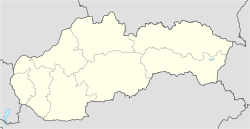Sklabiňa (Hungarian: Szklabinya) is a village and municipality in Martin District in the Žilina Region of northern Slovakia.
Sklabiňa | |
|---|---|
Village | |
 Sklabiňa | |
| Coordinates: 49°03′N 19°01′E / 49.050°N 19.017°E | |
| Country | Slovakia |
| Region | Žilina |
| District | Martin |
| First mentioned | 1242 |
| Area | |
| • Total | 11.06[2] km2 (4.27[2] sq mi) |
| Elevation | 484[3] m (1,588[3] ft) |
| Population (2021) | |
| • Total | 646[1] |
| Postal code | 038 03[3] |
| Area code | +421 43[3] |
| Car plate | MT |
| Website | www.obecsklabina.sk |
Names
editThe name is derived from the word Sclavus, Sclabus (Slav).[5] In historical records the village was first mentioned in 1242 - Zklabonya, later as Sclabonya (1252), Sclouuan (Slovan - the native name of Slavs, 1266), Sclabana (1309) but also as Szklabinka (1736) or in the Hungarized form Szklabinya (1786).
History
editThe locality was settled already by the people of Púchov culture who built a hillfort near the present-day village. The remains of the hillfort were reused in the Early Middle Ages by the Slavs. The village has always had a close relationship to the Sklabiňa Castle, the seat of Turóc County. Before the establishment of independent Czechoslovakia in 1918, the village was part of Turóc County within the Kingdom of Hungary. From 1939 to 1945, it was part of the Slovak Republic.
During the World War II the village became the center of the partisan movement. On 21 August 1944 (one week before the Slovak National Uprising), Sklabiňa became the first village where the partisans raised the Czechoslovak flag and declared that it is a liberated territory of Czechoslovakia. The partisan field trial executed at least 100 people, mostly members of the German minority.[6] The village suffered from several punitive expeditions. Among other, on 30 September 1944 Nazis imprisoned 144 citizens, 3 of them died during the questioning, additional 20 were executed together with other prisoners.
Geography
editThe municipality lies at an altitude of 480 metres and covers an area of 11.070 km2. It has a population of about 608 people.
References
edit- ^ "Počet obyvateľov podľa pohlavia - obce (ročne)". www.statistics.sk (in Slovak). Statistical Office of the Slovak Republic. 2022-03-31. Retrieved 2022-03-31.
- ^ a b "Hustota obyvateľstva - obce [om7014rr_ukaz: Rozloha (Štvorcový meter)]". www.statistics.sk (in Slovak). Statistical Office of the Slovak Republic. 2022-03-31. Retrieved 2022-03-31.
- ^ a b c d "Základná charakteristika". www.statistics.sk (in Slovak). Statistical Office of the Slovak Republic. 2015-04-17. Retrieved 2022-03-31.
- ^ a b "Hustota obyvateľstva - obce". www.statistics.sk (in Slovak). Statistical Office of the Slovak Republic. 2022-03-31. Retrieved 2022-03-31.
- ^ Uhlár, Vlado (1989). "Toponymá utvorené od etnických mien a názvy Slovany, Slovniky a Sklabiňa" [Toponyms derived from ethnic names and the names Slovany, Slovniky and Sklabiňa] (PDF). Slovenská reč (in Slovak) (54). Jazykovedný ústav Ľudovíta Štúra SAV.
- ^ Fremal, Karol (2005). "Slovenské národné povstanie a Sovietsky zväz" [Slovak National Uprising and the Soviet Union]. In Rastislav, Kožiak; Nagy, Imrich (eds.). Acta Historica Neosoliensia (PDF) (in Slovak). Banská Bystrica: Katedra histórie FHV UMB. ISBN 80-8083-173-4.
External links
edit

